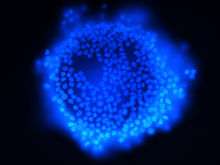Granulosa cell

A granulosa cell or follicular cell is a somatic cell of the sex cord that is closely associated with the developing female gamete (called an oocyte or egg) in the ovary of mammals.
Structure and function
In the primary ovarian follicle, and later in follicle development (folliculogenesis), granulosa cells advance to form a multilayered cumulus oophorus surrounding the oocyte in the preovulatory or antral (or Graafian) follicle.
The major functions of granulosa cells include the production of sex steroids, as well as myriad growth factors thought to interact with the oocyte during its development. The sex steroid production consists of follicle-stimulating hormone (FSH) stimulating granulosa cells to convert androgens (coming from the thecal cells) to estradiol by aromatase during the follicular phase of the menstrual cycle.[1] However, after ovulation the granulosa cells turn into granulosa lutein cells that produce progesterone. The progesterone may maintain a potential pregnancy and causes production of a thick cervical mucus that inhibits sperm entry into the uterus.
Embryology of ovarian granulosa cells
In the development of the urinary and reproductive organs, the oogonia become invaginated in the gonadal ridge.
The embryological origin of granulosa cells remains controversial. In the 1970s, evidence emerged that the first cells to make contact with the oogonia were of mesonephric origin. It was suggested that mesonephric cells already closely associated with the oogonia proliferated throughout development to form the granulosa cell layer.[2][3][4] Recently, this hypothesis has been challenged with some thorough histology. Sawyer et al. hypothesized that in sheep most of the granulosa cells develop from cells of the mesothelium (i.e., epithelial cells from the presumptive surface epithelium of the ovary).[5] In 2013 it was proposed that both granulosa cells and the ovarian surface epithelial cells are instead derived from a precursor cell called Gonadal-Ridge Epithelial-like cell. [6]
Cell culture
Cell culture of granulosa cells can be performed in vitro. Plating density (number of cells per volume of culture medium) plays a critical role for the differentiation. A lower plating density makes granulosa cells exhibit estrogen production, while a higher plating density makes them appear as progesterone producing theca lutein cells.[7]
See also
References
- ↑ Garzo, V. G.; Dorrington, J. H. (1984). "Aromatase activity in human granulosa cells during follicular development and the modulation by follicle-stimulating hormone and insulin". American Journal of Obstetrics and Gynecology. 148 (5): 657–662. doi:10.1016/0002-9378(84)90769-5. PMID 6422764.
- ↑ Satoh M (1991). "Histogenesis and organogenesis of the gonad in human embryos". J Anat. 177: 85–107. PMC 1260417
 . PMID 1769902.
. PMID 1769902. - ↑ Upadhyay S, Zamboni L (1982). "Preliminary observations on the role of the mesonephros in the development of the adrenal cortex". Anat Rec. 202 (1): 105–111. doi:10.1002/ar.1092020112. PMID 7059014.
- ↑ Zamboni, L.; Bezard, J.; Mauleon, P. (1979). "The role of the mesonephros in the development of the sheep fetal ovary". Annales de Biologie Animal Biochimie et Biophysique. 19: 1153–78. doi:10.1051/rnd:19790801.
- ↑ Sawyer H, Smith P, Heath D, Juengel J, Wakefield S, McNatty K (2002). "Formation of ovarian follicles during fetal development in sheep". Biol Reprod. 66 (4): 1134–50. doi:10.1095/biolreprod66.4.1134. PMID 11906935.
- ↑ Hummitzsch, K; Irving-Rodgers, HF; Hatzirodos, N; Bonner, W; Sabatier, L; Reinhardt, DP; Sado, Y; Ninomiya, Y; Wilhelm, D; Rodgers, RJ (2013). "A new model of development of the mammalian ovary and follicles.". PLOS ONE. 8 (2): e55578. doi:10.1371/journal.pone.0055578. PMC 3567121
 . PMID 23409002.
. PMID 23409002. - ↑ Portela VM, Zamberlam G, Price CA (April 2010). "Cell plating density alters the ratio of estrogenic to progestagenic enzyme gene expression in cultured granulosa cells". Fertil. Steril. 93 (6): 2050–5. doi:10.1016/j.fertnstert.2009.01.151. PMID 19324349.
External links
- Histology image: 18404loa – Histology Learning System at Boston University - "Female Reproductive System: ovary, cumulus oophorus"
- Histology image: 14808loa – Histology Learning System at Boston University - "Female Reproductive System: ovary, membrana granulosa"
- Granulosa Cells at the US National Library of Medicine Medical Subject Headings (MeSH)